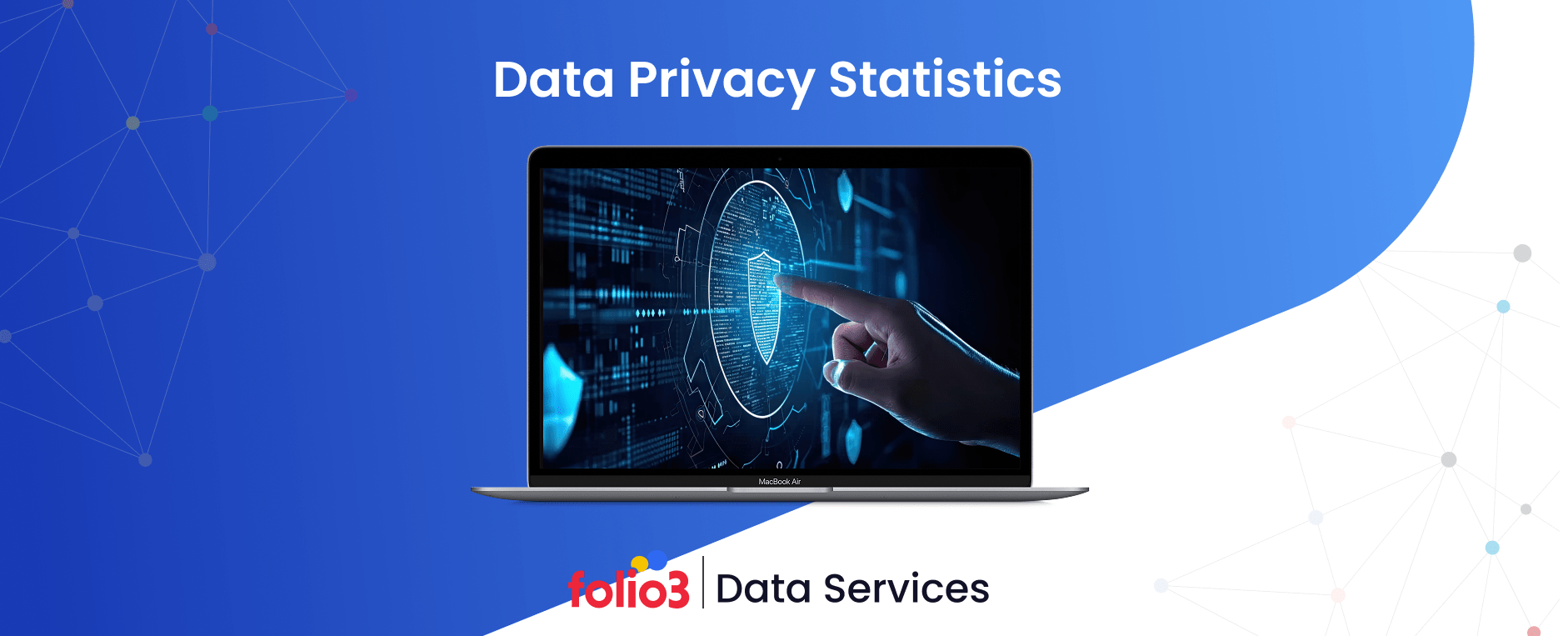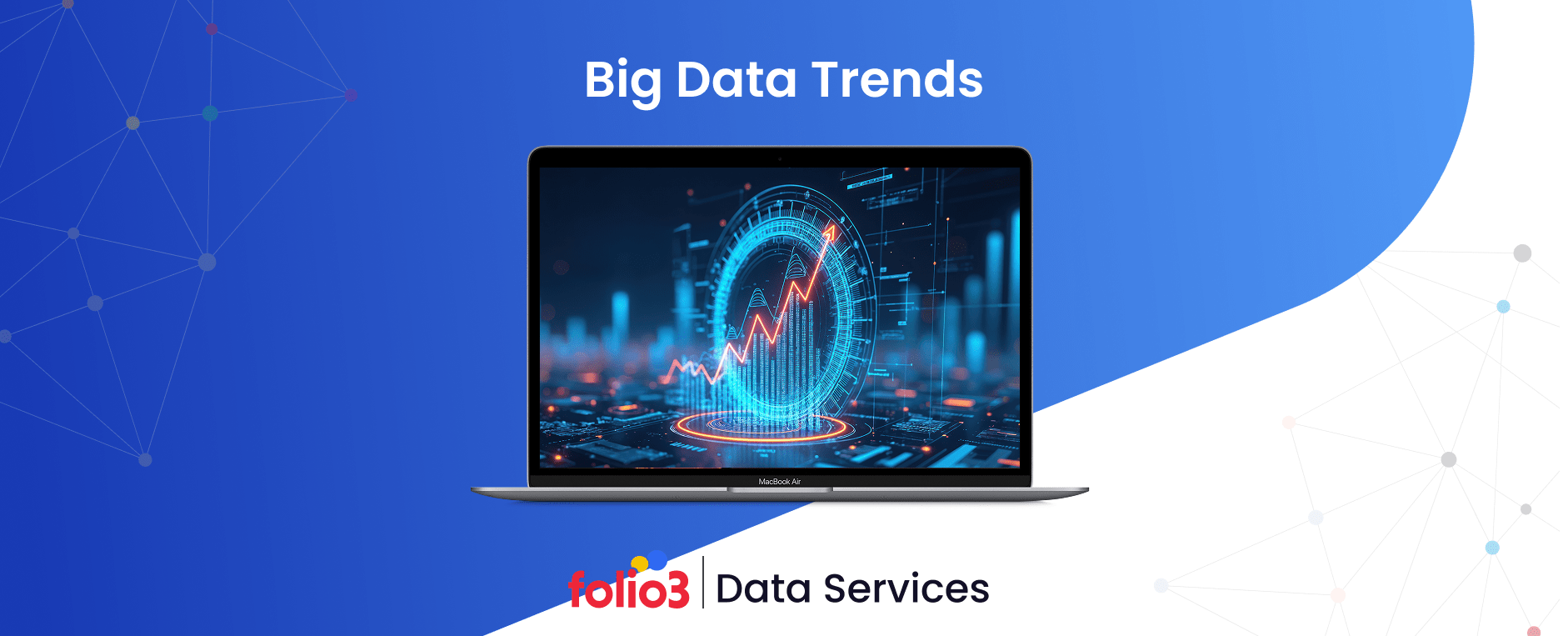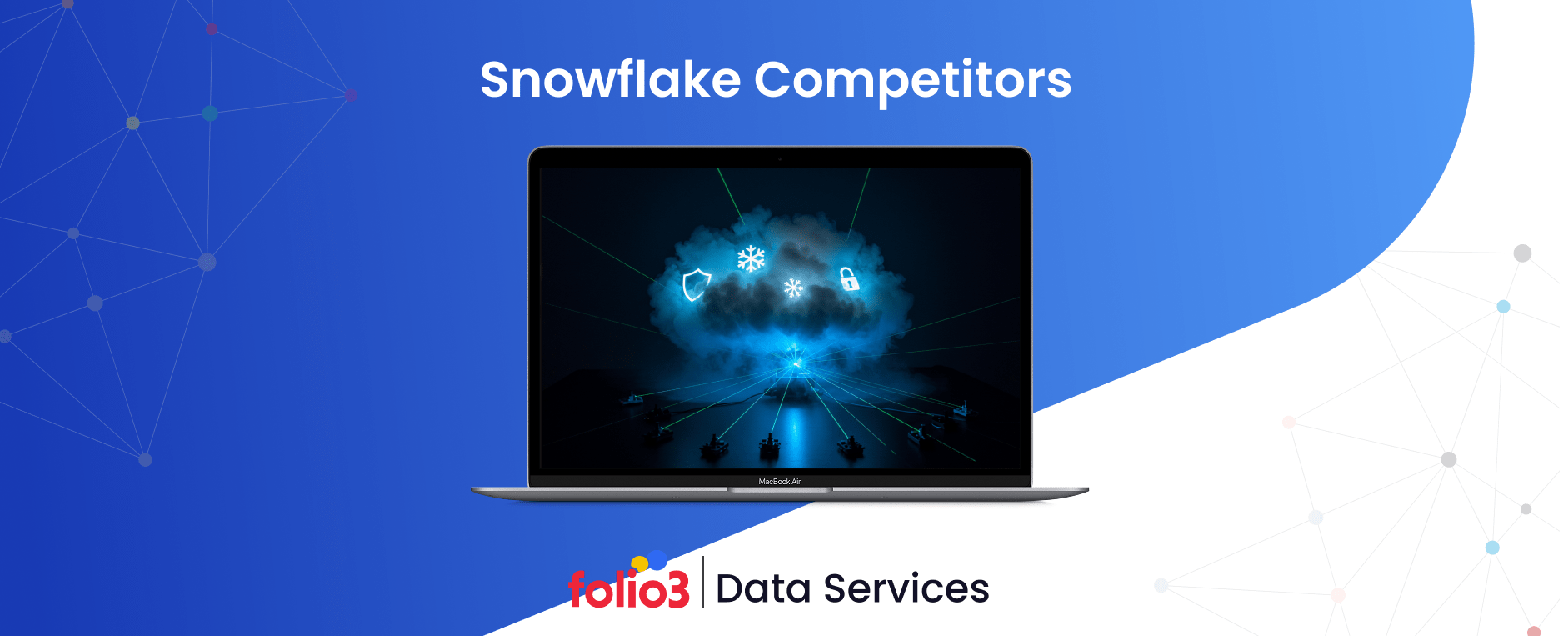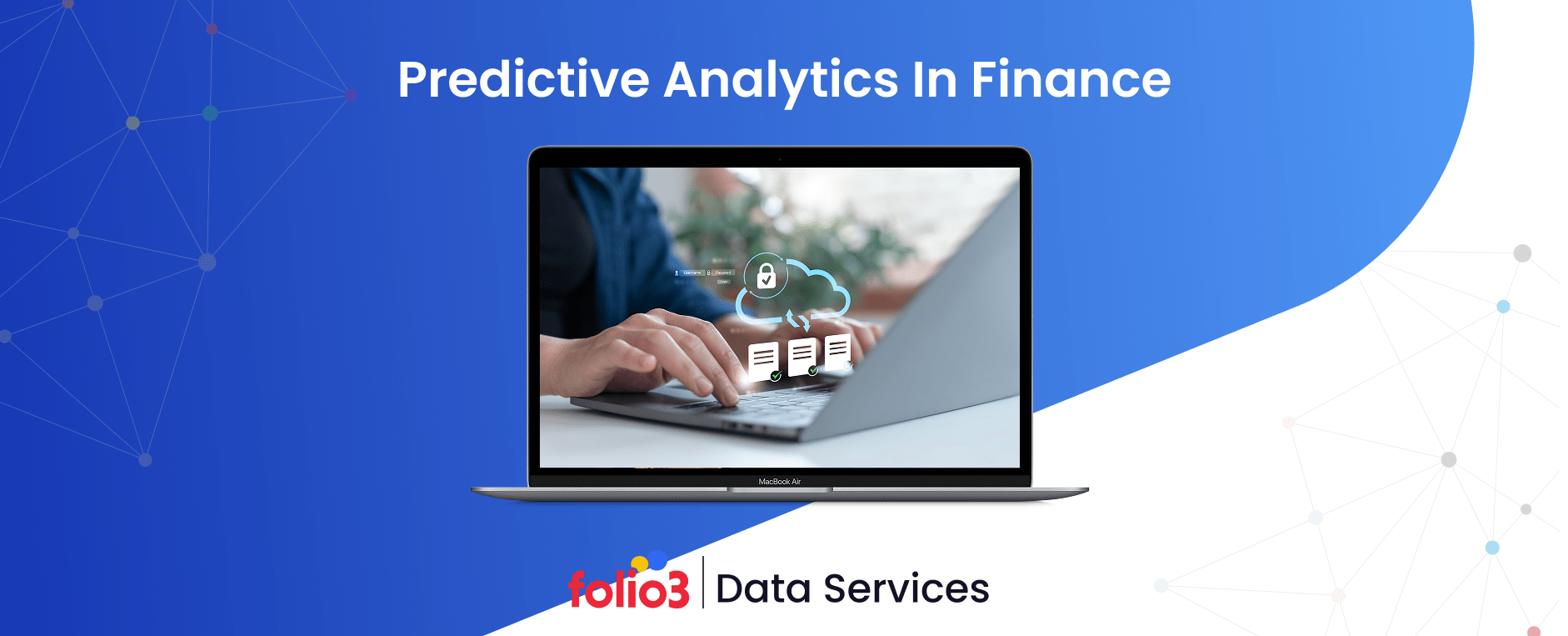The digital transformation accelerated by recent global events has fundamentally altered how enterprises collect, process, and protect customer data. As we navigate through 2025, data privacy has evolved from a compliance checkbox to a strategic business imperative that directly impacts revenue, customer trust, and competitive positioning.
The numbers paint a stark picture of our current reality. The global data privacy software market is projected to grow from USD 5.37 billion in 2025 to USD 45.13 billion by 2032, representing a compound annual growth rate of 35.5%. This explosive growth reflects not just regulatory pressure, but genuine business recognition that privacy protection is essential for sustainable operations.
Consumer behavior has shifted dramatically. 83% of consumers now consider whether they trust a company to keep their information safe before making a purchase, while 64% of consumers report they have opted not to work with a business because of privacy concerns. These statistics reveal that privacy has become a critical factor in customer acquisition and retention strategies.
For enterprise leaders, understanding the current landscape through concrete data points is essential for making informed decisions about privacy investments, compliance strategies, and customer trust initiatives. This comprehensive analysis examines the latest statistics shaping enterprise privacy strategies in 2025.
Top Data Privacy Statistics (Editor’s Choice)
Current data privacy statistics reveal fundamental shifts in how enterprises must approach customer data management, with implications extending far beyond compliance requirements.
- 85% of adults worldwide want to take greater steps to protect their online privacy. (Exploding Topics)
- The average cost of a U.S. data breach climbed to $10.22 million in 2025, with healthcare ($11.05M) and financial services ($6.08M) hit hardest. (IBM Report)
- 81% of consumers now factor in trust before making a purchase. (Edelman)
- 9 out of 10 Americans see online privacy as an important issue. (Surfshark)
- Only 58% of organizations are fully GDPR-compliant, facing similar CCPA gaps and rising compliance risks
- 1 in 6 data breaches now involve AI-driven attacks. (IBM Report)
- 40% of organizations report AI-related privacy breaches. (Protecto)
- Breaches take an average of 181 days to detect and 60 days to contain in 2025. (IBM Report)
Online Privacy Statistics & Insights
Digital privacy concerns are fundamentally altering how consumers interact with online services, creating new challenges and opportunities for enterprises across all sectors.
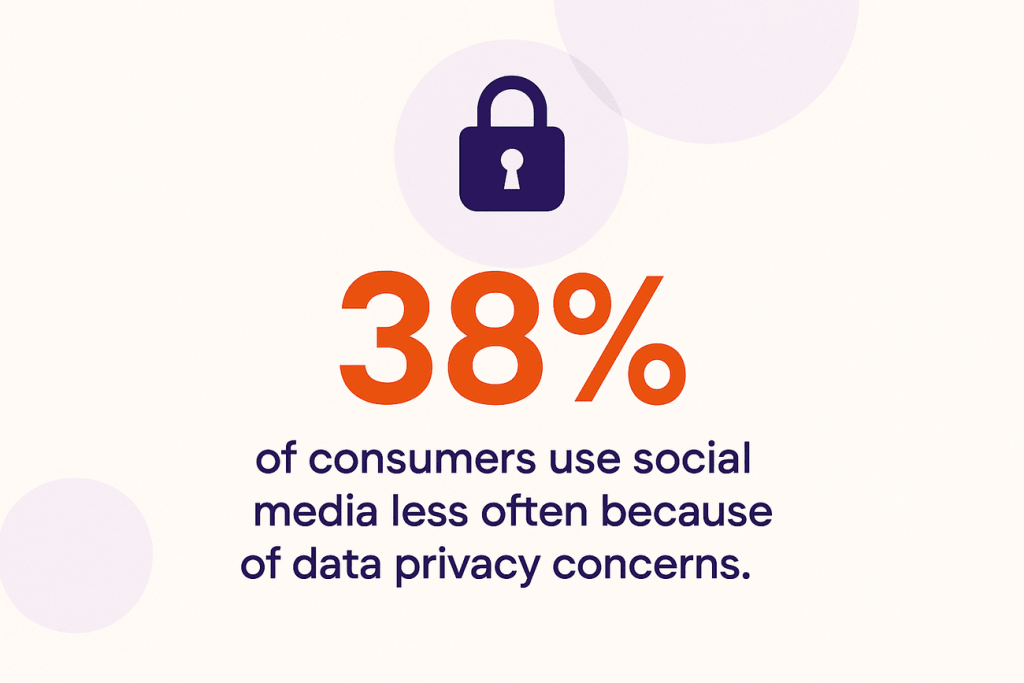
- 38% of consumers say they use social media less frequently due to growing concerns about how their data is collected and used. (SAS)
- 36% have completely deleted social media accounts over privacy worries. (SAS)
- 23% of global internet users now use VPNs regularly to protect their personal information and browsing activity. (AstrillVPN)
- 37% of users rely on ad blockers, limiting data tracking and affecting digital advertising performance. (EAB)
- Nearly 9 in 10 Europeans express concern about their privacy and say they’d be more likely to use AI if they were confident their data was protected. (EuroNews)
- 74% of Asia-Pacific consumers also worry about online data collection, though awareness varies by country. (PwC)
- Only 41% of websites provide clear, easy-to-understand cookie consent options that genuinely inform users. (MDPI)
- 67% of users admit to clicking “accept all” on cookie pop-ups without reading the privacy details. (Syrenis)
Data Breach & Security Stats
Data breach statistics are vital for enterprise risk assessment and security investment planning. They expose patterns that directly affect business continuity, financial performance, and brand trust.
Rising Breach Frequency
- In 2023, 3,205 breaches impacted over 353 million individuals, thats a 78% jump from the prior year. Mega-breaches, often targeting major platforms, are increasingly common and amplify systemic risks for dependent organizations. (ITRC)
Industry-Specific Trends
- Healthcare: 34% of all reported breaches, driven by sensitive data and complex infrastructures. (HIPAA Journal)
- Financial services: Kroll reported that the financial sector accounted for 27% of the breaches it handled in 2023, with a significant increase in interactive intrusion activities against the industry. (Kroll)
- Technology firms: 18% of breaches, but often the most disruptive due to centralized services cascading across millions of users. (HIPAA Journal)
| Industry | Share of Reported Breaches | Key Insights |
| Healthcare | 34% | Driven by sensitive patient data and complex infrastructures |
| Financial Services | 27% | Experiencing a surge in intrusion activities targeting financial systems. |
| Technology Firms | 18% | Breaches tend to be highly disruptive due to centralized services affecting millions of users. |
Detection and Response Timelines
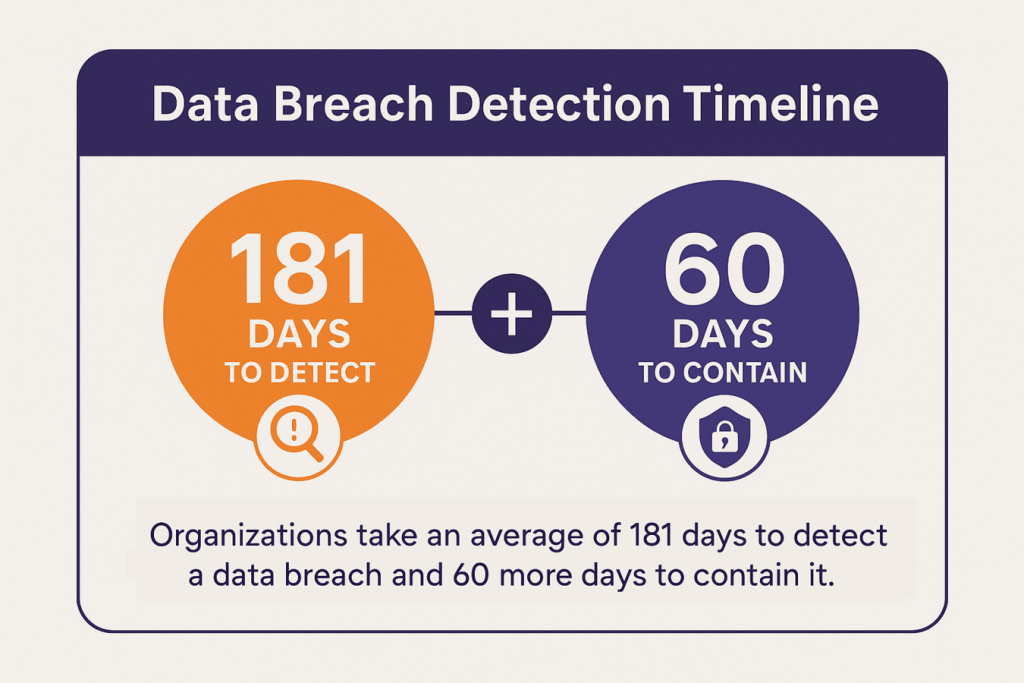
- On average, organizations take 181 days to detect a data breach and an additional 60 days to fully contain it, highlighting the lengthy and complex process of identifying and responding to cybersecurity incidents.
Common Attack Vectors
- Compromised credentials: Only 10% of breaches, enabled by theft or weak authentication.
- Phishing: 16%, exploiting human vulnerabilities as gateways to deeper intrusions.
- Cloud misconfigurations: 15%, underscoring the challenge of securing rapidly expanding cloud environments.
Source: (IBM)
Strategic Implication
For leaders, these statistics emphasize that breach resilience depends on faster detection, sector-specific defenses, and cloud governance not just compliance. Proactive investment in monitoring, identity protection, and developing data protection strategies is now a core pillar of enterprise security planning.
Consumer Data Privacy Statistics
Consumer attitudes toward data privacy reveal fundamental shifts in customer expectations that enterprises must address to maintain trust and competitive positioning in evolving markets.
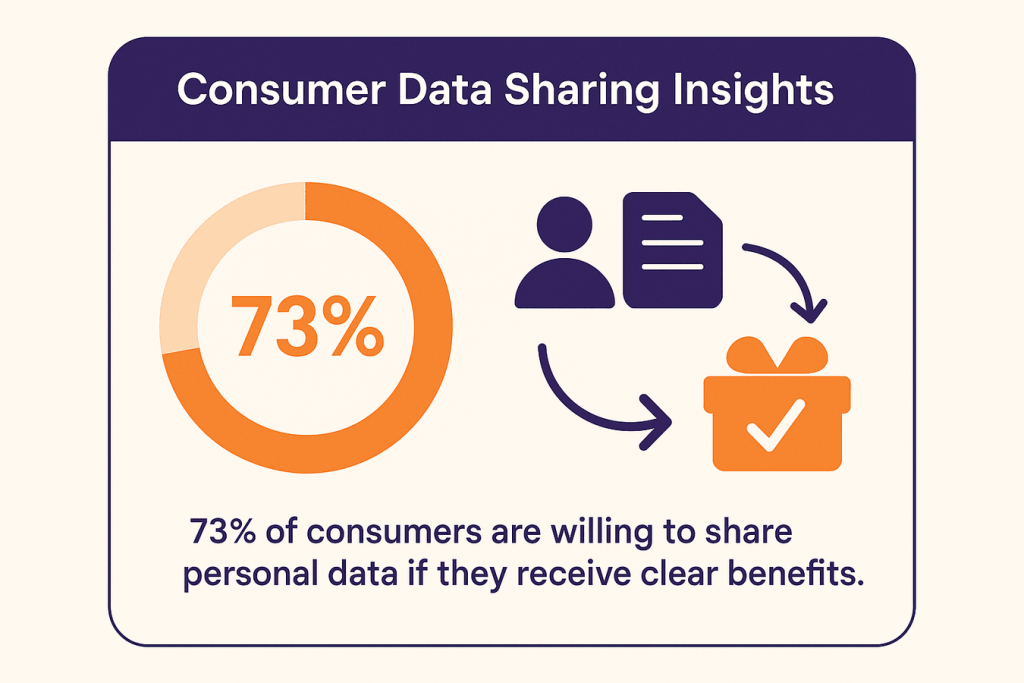
- 73% of consumers are willing to share personal data if they receive clear benefits. (Accenture)
- Data sharing acceptance is highest for security (67%) and healthcare (61%), but drops to 34% for marketing purposes. (GDMA)
- 87% of consumers indicated they would stop doing business with a company if it mishandled their personal information. (TechRadar)
- 84% of consumers want control over what information companies collect. (Forbes)
- 79% of customers expect easy access to their stored personal data. (SalesForce)
- 82% of Gen Z were somewhat or very concerned about privacy when using social networking sites, yet 97% had at least one active social media account. (UMass Dartmouth)
Furthermore, Millennials selectively share data, balancing convenience with privacy, while Gen X and Baby Boomers increasingly value privacy but require simpler controls to feel secure.
Mobile Data Privacy Statistics
Mobile privacy presents unique challenges for enterprises as smartphones become primary customer interaction points, creating both opportunities for engagement and significant privacy risks that require specialized management approaches.
As smartphones become primary customer and employee touchpoints, mobile data privacy introduces unique risks that enterprises must address within their digital and security strategies. These statistics highlight that enterprise mobile strategies must integrate privacy by design, ensuring regulatory compliance, user trust, and balanced governance in hybrid personal-business environments:
Mobile App Data Collection Risks
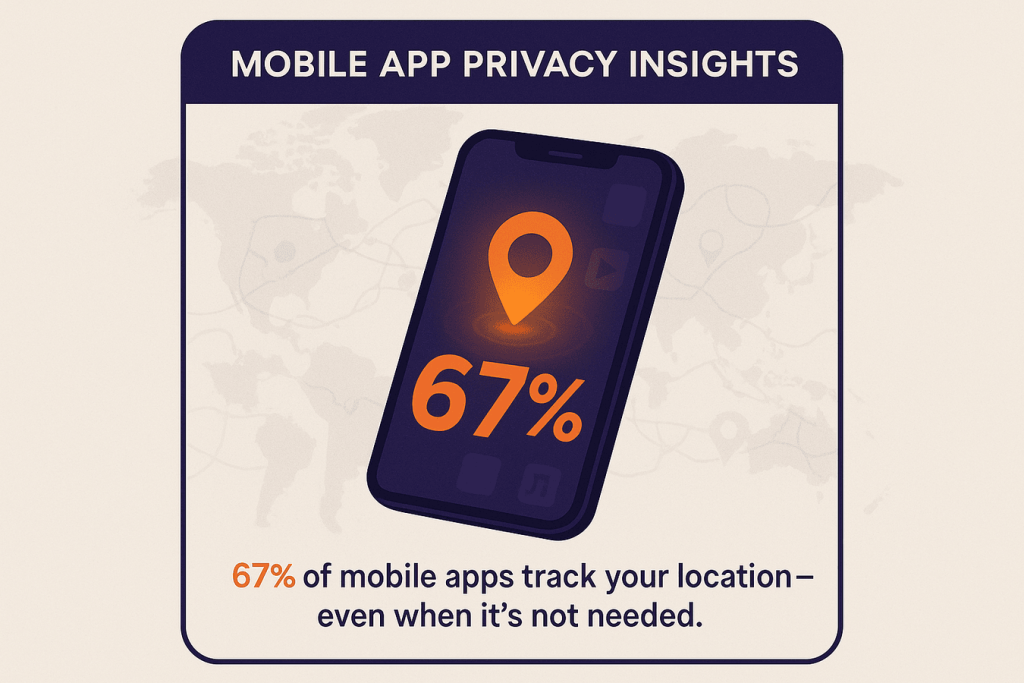
- Studies show 67% of mobile apps collect location data, often without clear connection to core functionality. (PMC)
- Likewise, 46% request access to contacts, exposing not only users but also third parties who never consented. (Security)
- Meanwhile, 82% collect device identifiers for analytics and advertising, creating tracking capabilities that most users neither expect nor fully understand. (SafetyDetectives)
User Permission Behaviors
- Pew Research Center analyzed over 1 million Android apps and found that the average app requests 5 permissions. (PEW)
- 77% of Android users have declined to install an app due to the permissions it requires. (ResearchGate)
- 68.3% of iOS users and 67.5% of Android users would likely deny tracking permissions if requested in-app, indicating a strong preference for privacy among users. (Pollfish)
Privacy Tool Adoption
Demand for stronger protection is evident:
- 72% of VPN users utilize them on desktop or laptop computers, while about 69% use VPNs on mobile devices. This indicates that mobile VPN usage is nearly as prevalent as desktop usage, with a slight edge towards desktops. (Windscribe)
- A study by Censuswide, commissioned by Ghostery, reported that 52% of Americans use ad blockers, up from 34% in 2022. (The Register)
Business & Organizational Privacy Practices
Enterprises are reshaping privacy practices to balance compliance, operational efficiency, and consumer trust. Data shows that while progress is steady, significant execution gaps remain.
Formal Privacy Policies
- 98% of organizations report privacy metrics to their board of directors, suggesting a widespread commitment to privacy governance. (Cisco)
- 64% of organizations have a privacy risk management program fully integrated into their overall enterprise risk management framework. (IAPP)
Regulatory Compliance Gaps
Only 20% of companies believed they were fully compliant with GDPR, while 53% were in the implementation phase and 27% had not yet started. (Channel Futures)
Complexity grows for multinationals managing overlapping jurisdictions. Companies with dedicated privacy teams and regular audits report higher compliance rates than those with ad-hoc management.
Investment in Privacy Technologies
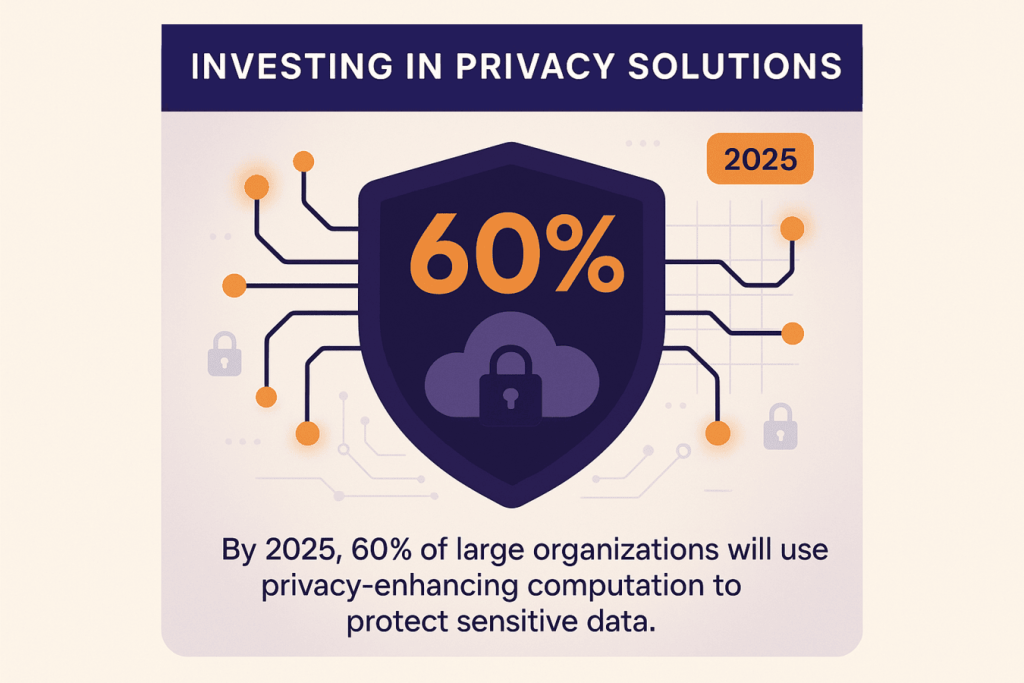
By 2025, 60% of large organizations will deploy privacy-enhancing computation (PEC) to safeguard sensitive data while preserving utility. (Gartner)
Adoption of differential privacy is accelerating in healthcare and finance, enabling aggregate analysis without exposing individuals.
As organizations expand their data and analytics solutions, technologies like homomorphic encryption are gaining traction for cloud analytics, allowing computation on encrypted data while maintaining confidentiality—though technical complexity remains a barrier.
Employee Training and Awareness
The average employee training completion rate across industries is approximately 72%. (Getmonetizely)
Ongoing privacy testing and scenario-based training deliver stronger outcomes than one-time sessions. Increasingly, cross-functional training extends to marketing, sales, and customer service, recognizing that privacy touches all customer-facing activities, not just IT and legal.
Data Privacy Statistics by Industry
Industry-specific privacy challenges require tailored approaches that consider regulatory requirements, data sensitivity levels, customer expectations, and operational constraints unique to each sector:
Healthcare: Patient Data and HIPAA Compliance
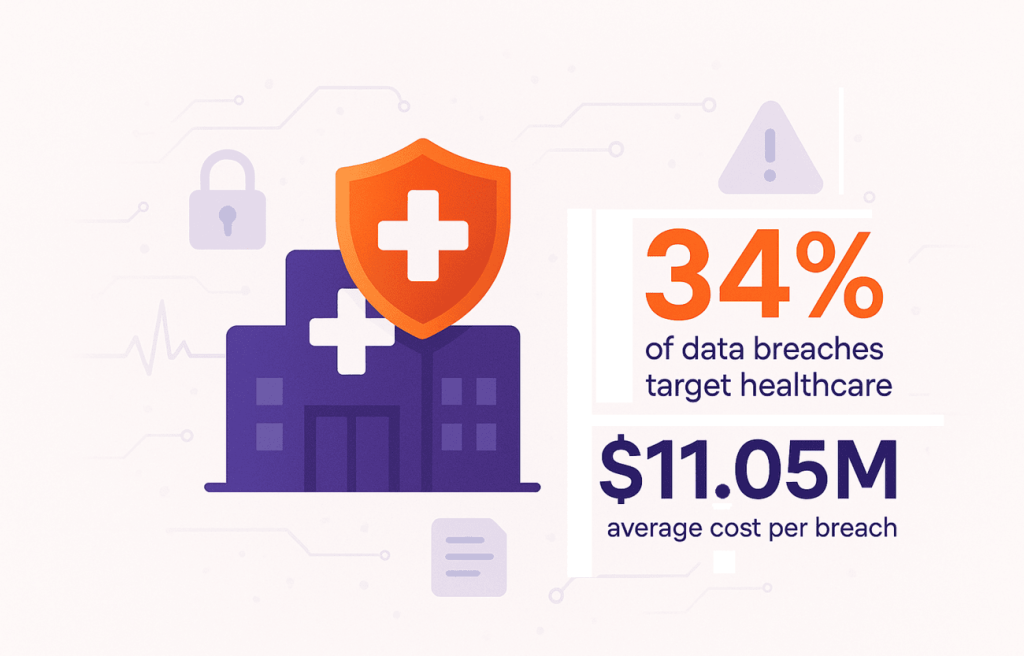
Healthcare remains the most targeted sector, accounting for 34% of breaches and averaging $11.05M per incident, the highest across industries. Valuable patient records and outdated systems drive risk. (IT Governance)
While 89% of organizations report HIPAA programs, effectiveness varies by technical safeguards and staff training. Digital health adoption via telemedicine, wearables, and AI creates new privacy touchpoints, requiring strict safeguards without hindering patient experience.
Financial Services: Balancing Trust and Regulation
Financial institutions face overlapping mandates (PCI DSS, SOX, consumer protections) while managing fraud risks. Breaches cost an average of $6.08M, magnified by fines and churn. (IBM)
Customer trust is critical; privacy failures often trigger immediate account closures. Open banking and fintech APIs expand exposure, demanding stronger consent management. Digital banking adoption further increases attack surfaces, requiring continuous monitoring.
Retail & E-Commerce: Personalization vs. Privacy
Retailers rely on customer data for personalization, loyalty programs, and omnichannel experiences.
Among the most impactful big data use cases in retail are personalized recommendations and predictive buying insights, which help brands enhance customer engagement while maintaining transparency.
However, consumers demand both relevance and transparency, pressuring brands to implement consent-driven models. Cross-border e-commerce adds regulatory complexity, while loyalty programs with clear protections see higher engagement than those with vague policies.
Social Media: Scale and Accountability
Platforms process billions of interactions daily, making privacy protection a technical challenge. Strong data governance frameworks are now essential to manage how user data is collected, stored, and shared responsibly.
Regulatory and litigation pressures are expanding liability, requiring governance frameworks that extend to third-party advertisers. Users increasingly demand granular privacy controls, data portability, and algorithmic transparency, forcing costly infrastructure investments.
Government: Citizen Data and Transparency
Governments manage vast citizen datasets but face legacy systems, resource limits, and overlapping regulations. Rising citizen expectations demand clear communication on data collection and use. Inter-agency sharing for services and law enforcement requires policies that balance efficiency with privacy rights.
Regional Data Privacy Statistics
Data privacy practices vary widely across regions, shaped by regulations, consumer expectations, and business priorities, creating both challenges and opportunities for global enterprises.
- North America is defined by a patchwork of state-level laws, with California’s CCPA leading the way. This fragmented approach increases compliance complexity. While 71% of consumers express concern about data collection, many continue using services despite reservations, highlighting a gap between awareness and behavior. (Bloomberg Law)
- Europe remains the global privacy leader, with GDPR setting the benchmark. However, compliance rates linger at 58%, reflecting the regulation’s complexity. European consumers are the most privacy-conscious worldwide, with 78% voicing concerns and more likely to abandon services over privacy risks. (European Union)
- Asia-Pacific presents significant variation. Nations like Japan and South Korea enforce comprehensive frameworks, while others are still maturing. Consumer awareness averages 64% but differs widely by country. Businesses here often prioritize convenience, though attitudes are shifting as regulations strengthen. (Freshfields)
Data Privacy Regulations & Compliance Statistics
The expanding landscape of data privacy regulations creates complex compliance requirements for enterprises, with significant financial and operational implications for organizations operating across multiple jurisdictions, such as:
GDPR: Global Benchmark
Since implementation, the GDPR has issued over €2.4B in fines, with major violations exceeding 4% of annual revenue. While the average fine is €1.8M, compliance costs remain high, averaging €1.3M per organization.
Yet, only 58% of companies are fully compliant, with gaps in consent management, data rights, and impact assessments. Enforcement trends show regulators targeting core privacy principles rather than just technical lapses, signaling more sophisticated oversight. (SEC.GOV)
CCPA and State-Level Expansion
The CCPA, enforced by the California Privacy Protection Agency, applies to any business serving Californians, with enforcement actions reaching the low millions of dollars per case.
Beyond California, around 20 states have enacted comprehensive privacy laws as of 2025, creating a fragmented regulatory landscape that pushes businesses to strengthen compliance frameworks and prepare for possible federal legislation. (White Case)
Global Privacy Laws
Major privacy frameworks are expanding worldwide. Brazil’s LGPD allows fines up to R$ 50 million (~US$10 million) per violation; India’s DPDP Act (2023) strengthens consent rules and limits certain cross-border transfers; and China’s PIPL imposes strict extraterritorial and transfer requirements.
Across Africa, Latin America, and Asia-Pacific, GDPR-inspired laws continue to proliferate, reshaping global compliance expectations. (IAPP)
Multi-Jurisdictional Complexity
Global organizations must navigate overlapping requirements, inconsistent enforcement, and varying data residency rules.
Consent management is especially complex, as standards differ across regions. With limited coordination among regulators, businesses must often comply with the most restrictive standard to minimize risk.
Future of Data Privacy: Trends to Watch
Data privacy is evolving rapidly, shaped by new technologies, stricter regulations, and rising consumer expectations. Forward-looking enterprises must adapt to stay compliant and competitive and watch out to such trends like:
Privacy-by-Design as a Standard
What began as a regulatory requirement is now a business advantage. Embedding privacy from the start through data minimization, automated controls, and purpose-limited systems reduces compliance costs, enhances efficiency, and fosters consumer trust. Cross-functional collaboration ensures privacy influences decisions at every stage.
Shift Toward Zero- and First-Party Data
With third-party data becoming less reliable due to regulations and browser restrictions, businesses are turning to zero- and first-party strategies. These rely on direct engagement, preference centers, and voluntary customer input, strengthening relationships while respecting privacy.
Aligning these efforts with a thoughtful data strategy and governance approach helps organizations build trust while maintaining compliance.
AI-Powered Privacy Tools
Artificial intelligence is transforming privacy management through automated risk detection, dynamic controls, and consent enforcement. Machine learning enables proactive protection at scale, and implementing generative AI further enhances automated privacy management, though privacy-preserving techniques are essential to mitigate AI’s own risks.
Emerging Global Standards
While full harmonization remains unlikely, cross-border coordination and industry-specific frameworks are reducing compliance burdens. Risk-based approaches and technical standards from bodies like ISO and NIST signal a shift toward more flexible, mature privacy management.
FAQs
How many data breaches occur each year?
Millions of breaches are reported annually, with incidents rising steadily due to increased digital activity and cybercrime.
Which industries experience the most data privacy incidents?
Healthcare, finance, and technology face the highest rates of breaches due to the sensitivity and volume of data they manage.
What are the main global privacy regulations?
Key regulations include GDPR in Europe, CCPA in California, Brazil’s LGPD, and evolving frameworks across Asia-Pacific and emerging economies.
How much does a data breach cost businesses on average?
In 2025, the average cost of a breach in the U.S. is about $10.22 million, the highest globally.
What percentage of global adults want to do more to protect their online privacy?
Around 74% of adults worldwide want stronger control over their online privacy.
How do consumers feel about data privacy in 2025?
Consumers are highly concerned, with over 80% considering privacy a key factor in trusting a business.
What percentage of data breaches are caused by human error?
Roughly 21% of breaches stem from human mistakes such as misconfigurations or phishing.
How is AI changing data privacy practices?
AI improves threat detection and compliance automation but also raises concerns over surveillance and data misuse.
How much personal data is collected by mobile apps annually?
Billions of data points are harvested each year, mostly tied to location, browsing, and behavioral tracking.
What percentage of people use tools like VPNs, ad blockers, or private browsers to protect their privacy?
Over 40% of internet users rely on privacy tools such as VPNs or ad blockers.
What is the difference between data privacy and data security?
Data privacy governs how information is collected and used, while data security protects it from unauthorized access.
What proportion of consumer data is used for targeted advertising?
Nearly 50% of consumer data collected by companies is leveraged for personalized or targeted ads.
Conclusion
The data privacy landscape of 2025 brings both risks and opportunities. With breaches averaging $10.22 million in the U.S. and global cybercrime costs projected at $10.5 trillion, privacy is no longer optional, it’s important and strategic. Companies that adopt privacy-by-design and build customer trust gain lasting competitive advantage.
To stay ahead of these evolving regulations and use data responsibly, enterprises need expert support. Folio3’s data services help organizations achieve compliance, strengthen security, and unlock value from data while safeguarding customer trust.
If you’re also interested in how businesses are turning data into growth, insights, and innovation, explore our data analytics stats article — covering the latest market trends, adoption insights, ROI benchmarks, and the future of analytics in 2025.
